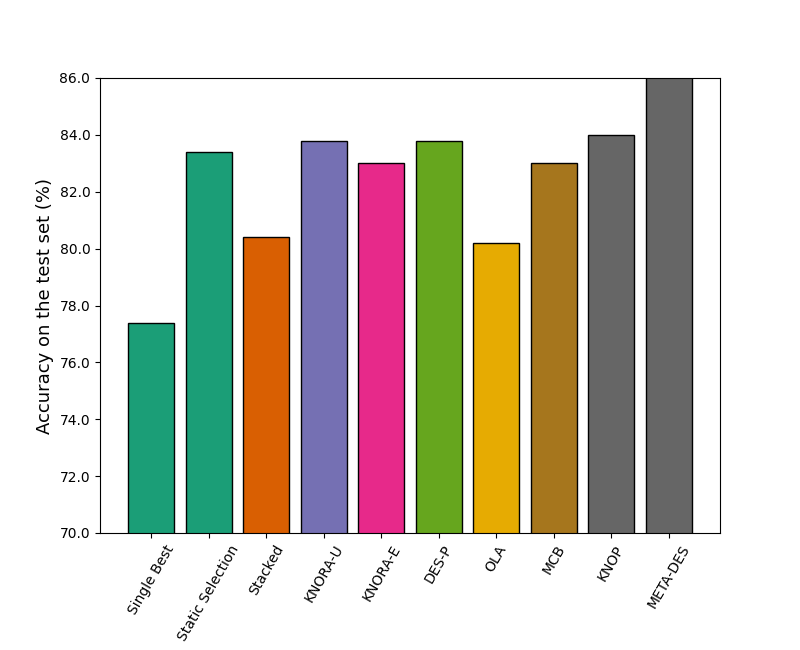Note
Click here to download the full example code
Comparing dynamic selection with baseline static methods¶
In this example we compare the performance of DS techinques with the static ensemble methods. DESlib offer the implementation of static ensemble methods in the deslib.static module. The following techniques are considered:
Static methods used as baseline comparison are in the deslib.static module. They are:
Majority Voting: The outputs of all base classifiers in the pool are combined using the majority voting rule
Static Selection: A fraction of the best performing classifiers (based on the validation data, is selected to compose the ensemble).
Single Best: The base classifier with the highest classification accuracy in the validation set is selected for classification
Stacked classifier: The outputs of all base classifiers are passed down to a meta-estimator which combines the . The meta-estimator is trained based on the outputs of the base classifiers on the training data.
These techniques are used in the dynamic selection literature as a baseline comparison (for more information see references [1] and [2])
At the end we also present the result of the Oracle, which is an abastract model which always selects the base classifier that predicted the correct label if such classifier exists. From the dynamic selection point of view, the Oracle is seen as the upper limit performance that can be achieved with the given pool of classifiers.
References¶
[1] Britto, Alceu S., Robert Sabourin, and Luiz ES Oliveira. “Dynamic selection of classifiers—a comprehensive review.” Pattern Recognition 47.11 (2014): 3665-3680.
[2] R. M. O. Cruz, R. Sabourin, and G. D. Cavalcanti, “Dynamic classifier selection: Recent advances and perspectives,” Information Fusion, vol. 41, pp. 195 – 216, 2018.
- [3] Kuncheva, Ludmila I. “A theoretical study on six classifier fusion
- strategies.” IEEE Transactions on Pattern Analysis & Machine Intelligence, (2002): 281-286.
import matplotlib.pyplot as plt
from matplotlib.ticker import FuncFormatter
from matplotlib.cm import get_cmap
import numpy as np
# Example of a dcs techniques
from deslib.dcs import OLA
from deslib.dcs import MCB
from deslib.des import DESP
from deslib.des import KNORAU
from deslib.des.knora_e import KNORAE
from deslib.des import KNOP
from deslib.des import METADES
from sklearn.datasets import make_classification
from sklearn.ensemble import BaggingClassifier
from sklearn.model_selection import train_test_split
from sklearn.tree import DecisionTreeClassifier
# Example of a des techniques
# Example of stacked model
from deslib.static import (StackedClassifier,
SingleBest,
StaticSelection,
Oracle)
rng = np.random.RandomState(123)
# Generate a classification dataset
X, y = make_classification(n_samples=2000,
n_classes=3,
n_informative=6,
random_state=rng)
# split the data into training and test data
X_train, X_test, y_train, y_test = train_test_split(X, y, test_size=0.25,
random_state=rng)
X_train, X_dsel, y_train, y_dsel = train_test_split(X_train, y_train,
test_size=0.50,
random_state=rng)
pool_classifiers = BaggingClassifier(base_estimator=DecisionTreeClassifier(),
n_estimators=100,
random_state=rng)
pool_classifiers.fit(X_train, y_train)
# Setting up static methods.
stacked = StackedClassifier(pool_classifiers)
static_selection = StaticSelection(pool_classifiers)
single_best = SingleBest(pool_classifiers)
# Initialize a DS technique. Here we specify the size of
# the region of competence (5 neighbors)
knorau = KNORAU(pool_classifiers, random_state=rng)
kne = KNORAE(pool_classifiers, random_state=rng)
desp = DESP(pool_classifiers, random_state=rng)
ola = OLA(pool_classifiers, random_state=rng)
mcb = MCB(pool_classifiers, random_state=rng)
knop = KNOP(pool_classifiers, random_state=rng)
meta = METADES(pool_classifiers, random_state=rng)
names = ['Single Best', 'Static Selection', 'Stacked',
'KNORA-U', 'KNORA-E', 'DES-P', 'OLA', 'MCB', 'KNOP', 'META-DES']
methods = [single_best, static_selection, stacked,
knorau, kne, desp, ola, mcb, knop, meta]
# Fit the DS techniques
scores = []
for method, name in zip(methods, names):
method.fit(X_dsel, y_dsel)
scores.append(method.score(X_test, y_test))
print("Classification accuracy {} = {}"
.format(name, method.score(X_test, y_test)))
Out:
Classification accuracy Single Best = 0.774
Classification accuracy Static Selection = 0.834
Classification accuracy Stacked = 0.804
Classification accuracy KNORA-U = 0.838
Classification accuracy KNORA-E = 0.83
Classification accuracy DES-P = 0.838
Classification accuracy OLA = 0.802
Classification accuracy MCB = 0.83
Classification accuracy KNOP = 0.84
Classification accuracy META-DES = 0.862
Plotting the results¶
Let’s now evaluate the methods on the test set.
cmap = get_cmap('Dark2')
colors = [cmap(i) for i in np.linspace(0, 1, 10)]
fig, ax = plt.subplots(figsize=(8, 6.5))
pct_formatter = FuncFormatter(lambda x, pos: '{:.1f}'.format(x * 100))
ax.bar(np.arange(len(methods)),
scores,
color=colors,
tick_label=names,
edgecolor='k')
ax.set_ylim(0.70, 0.86)
ax.set_ylabel('Accuracy on the test set (%)', fontsize=13)
ax.yaxis.set_major_formatter(pct_formatter)
for tick in ax.get_xticklabels():
tick.set_rotation(60)
plt.subplots_adjust(bottom=0.18)
plt.show()

The Oracle results¶
OracleAbstract method that always selects the base classifier that predicts the correct label if such classifier exists. This method is often used to measure the upper-limit performance that can be achieved by a dynamic classifier selection technique. It is used as a benchmark by several dynamic selection algorithms. We can see the Oracle performance is close to 100%, which is an almost 15% gap to the best performing method.
oracle = Oracle(pool_classifiers).fit(X_train, y_train)
print('Oracle result: {}' .format(oracle.score(X_test, y_test)))
Out:
Oracle result: 0.998
Total running time of the script: ( 0 minutes 5.055 seconds)